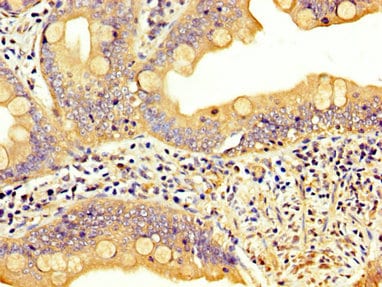Anti-LPP antibody (ab234999)
Key features and details
- Rabbit polyclonal to LPP
- Suitable for: IHC-P, WB
- Reacts with: Human
- Isotype: IgG
Overview
-
Product name
Anti-LPP antibody
See all LPP primary antibodies -
Description
Rabbit polyclonal to LPP -
Host species
Rabbit -
Tested Applications & Species
See all applications and species dataApplication Species WB Human -
Immunogen
Recombinant fragment corresponding to Human LPP aa 200-400.
Database link: Q93052 -
Positive control
- WB: HEK-293T whole cell lysate. IHC-P: Human small intestine and pancreatic cancer tissues.
Properties
-
Form
Liquid -
Storage instructions
Shipped at 4°C. Store at +4°C short term (1-2 weeks). Upon delivery aliquot. Store at -20°C long term. Avoid freeze / thaw cycle. -
Storage buffer
pH: 7.40
Constituents: PBS, 50% Glycerol (glycerin, glycerine), 0.03% Proclin 300 -
 Concentration information loading...
Concentration information loading... -
Purity
Protein G purified -
Purification notes
Purity >95%. -
Clonality
Polyclonal -
Isotype
IgG -
Research areas
Images
-
Paraffin-embedded small intestine tissue stained for LPP using ab234999 at 1/300 dilution in immunohistochemical analysis.
After dewaxing and hydraton, antigel retrieval was mediated by high pressure in a citrate buffer (pH 6.0). Section was blocked with 10% normal goat serum for 30 minutes at room temperature. Then primary antibody (1% BSA) was incubated at 4°C overnight. The primary is detected by a biotinylated secondary antibosy and visualized using an HRP conjugated SP system.
-
Anti-LPP antibody (ab234999) at 1/500 dilution + HEK-293T (human epithelial cell line from embryonic kidney transformed with large T antigen) whole cell lysate
Secondary
Goat polyclonal to rabbit IgG at 1/50000 dilution
Predicted band size: 66 kDa
-
Paraffin-embedded pancreatic cancer tissue stained for LPP using ab234999 at 1/300 dilution in immunohistochemical analysis.
After dewaxing and hydraton, antigel retrieval was mediated by high pressure in a citrate buffer (pH 6.0). Section was blocked with 10% normal goat serum for 30 minutes at room temperature. Then primary antibody (1% BSA) was incubated at 4°C overnight. The primary is detected by a biotinylated secondary antibosy and visualized using an HRP conjugated SP system.
















